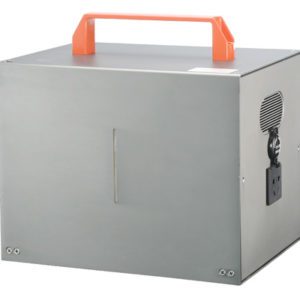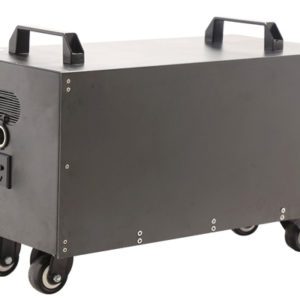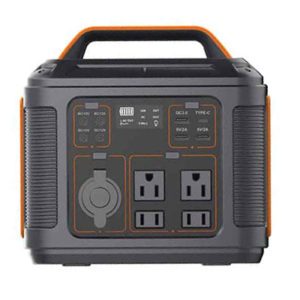
What is a portable power station?
In short, it’s a unit that powers other electronics using a rechargeable battery. They can be big enough for home backup or small enough to take camping. They generally have some combination of AC (wall) outlets, USB outlets, and sometimes less common types of outlets. What makes them different from other energy storage devices is that they balance high capacity with portability.
Is a portable power station just a big battery?
Is a bank just a vault? Though the battery is the main part of a portable power station, there are also a number of components and technologies that send stored energy safely and efficiently to your appliances. They have tech that makes them recharge faster, screens that show input and output, and even apps for remote energy management.
What’s the difference between a solar generator and a portable power station?
Just the names – neither a portable power station nor a solar generator create energy, they just store it so you can use it anytime. The same goes for battery-powered generators. The “solar” element just indicates that generators can connect to solar panels, but so can portable power stations with an XT60 port.
How is a portable power station different from a power bank?
Portable power stations have much more capacity and outlets than power banks, which usually only have USB outlets. Portable power stations can be used for things that would normally plug into a wall or car outlet. This is because they have enough juice to power big things for a while and can send out more electricity.
What should I look for when choosing a portable power station?
Capacity, portability, lifespan, and features are what make certain models right for some and not others. The type of battery used will have a big impact on the first three. NCM batteries are lighter while LFP batteries have a longer lifespan.
Capacity
How much electricity a portable power station can store is measured in watt-hours (Wh), which is one watt of electricity being used for (you guessed it!) one hour. That means a 500Wh portable power station would power a 50W bulb for 10 hours (if it were 100% efficient).
So, let’s say you’re throwing an outdoor summer party for 3 hours and plan to bring:
• Iceless cooler (50 watts)
• Set of lights (25 watts)
• Slow cooker (75 watts)
All of the devices above add up to 150 watts, and if you need to power them for 3 hours, you would need 450Wh of capacity (technically speaking, you’ll need slightly more than that – there’s inversion loss and it’s best not to drain the battery to 0%).
Portability
Battery chemistries have moved away from the lead-acid ones found in cars, and as a result, are now much lighter and more efficient. We’re still not at the point where your house can run off of a battery the size of your phone, but we’re getting a lot closer. There are plenty of things you can use with today’s portable power stations that you couldn’t have done feasibly a few years ago.
The tradeoff between weight and capacity has reached the point where you can pick up a battery that can power a TV for 24 hours. Smaller sizes you can take on a hiking trip may be able to power small appliances for a few hours. If lifting it up isn’t necessary, bigger ones usually have wheels and can power large appliances and power tools for several hours.
Lifespan
Seeing a battery as an investment is sort of a new concept. Compare how many times portable power stations can be discharged and recharged by looking at the “cycle life”, which is expressed as something like 500 cycles to 80%.
A battery with a cycle life of 500 might not seem like a lot, but that’s probably as good or better than your phone’s battery. There are two reasons cycle life is more than it seems. One, cycles isn’t the same as uses. Say today you use 30% of its battery, tomorrow 20%, and 50% the next day – that’s only one cycle. The second thing is that it’s only to 80% health. The battery lasts 80% as long as it used to, but this is so gradual you may not notice.
Important: Don’t just compare cycles, make sure the “to __%” is the same. A company claiming 1000 cycles, may be way down to 50% health.
Features
At the very minimum, portable power stations should have USB and AC outlets. From there, the bells and whistles to keep in mind are solar panel compatibility, app functionality, expandable capacity (i.e., adding batteries), and having a variety of input and output ports.
JB BATTERY portable power stations
JB BATTERY portable power stations have been highlighted by top reviewers for their recharging times, high output, and iconic design. For electricity going in, we can proudly claim the world’s fastest recharge time. For electricity going out, outlets of all shapes and sizes let you bring along pretty much anything.
-
1500W Portable Power Station,1500Wh LiFePO4 Battery Backup ,high power LiFePO4 Battery pack,super power LiFePO4 Battery pack,110V/220V AC Outlets, Power storage for Outdoor Camping, RV Travel, Home Use
1. Portable power station
2. For all your outdoor power needs
3. High power LiFePo4 battery pack
4. Power supply for home,office, off grid,emergency
-
2500W Potable Power Station,2500Wh LiFePO4 Battery Backup ,high power LiFePO4 Battery pack,super power LiFePO4 Battery pack,110V/220V AC Outlets, Power storage for Outdoor Camping, RV Travel, Home Use
1. Portable power station
2. For all your outdoor power needs
3. High power LiFePo4 battery pack
4. Power supply for home,office, off grid,emergency
-
300W Multifunctional Portable Power Station 296Wh (80000mAh/3.7V) Backup Lithium Battery Power with 110V AC Outlet/2 DC Ports/3 USB Ports, Solar Generator for CPAP Outdoor Adventure Load Trip Camping Emergency with LED light & PD 45W
1. Built-in high-power density lithium-ion battery;
2. Up to 20Ah / 14.8V (equivalent to 80,000mAh, 3.7V) 296Wh battery power;
3. Support AC pure sine wave output;
4. The maximum AC continuous output is 300W, and the peak output is 450W;
5. Multiple DC outputs, up to 12-16V/12A continuous output, 13A protection.
6. Support 2 x 5V / 2A (maximum 4A max) and USB QuickCharge3.0 output, suitable for smartphones, tablet computers, etc.
7. Support PD100W input and output, support PD charger to charge energy storage power supply, and support PD100W to charge laptops, Nintendo game consoles, and other devices.
8. Built-in LED light board lighting.
9. Protection includes short circuit, overload, high-temperature resistance, etc.,
-
300W Multifunctional Portable Power Station 296Wh(80000mAh/3.7V),Backup Lithium Battery, 110V/200W Pure Sine Wave AC Outlet, Solar Generator (Solar Panel Not Included) for Outdoors Camping Travel Hunting Emergency
1. Built-in high-power density lithium-ion battery;
2. Up to 20Ah / 14.8V (equivalent to 80,000mAh,
3.7V) 296Wh battery power; 3. Support AC pure sine wave output;
4. The maximum AC continuous output is 300W, and the peak output is 450W;
5. Multiple DC outputs, up to 12-16V/12A continuous output, 13A protection.
6. Support 2 x 5V / 2A (maximum 4A max) and USB QuickCharge3.0 output, suitable for smartphones, tablet computers, etc.
7. Support PD100W input and output, support PD charger to charge energy storage power supply, and support PD100W to charge laptops, Nintendo game consoles, and other devices.
8. Built-in LED light board lighting.
9. Protection includes short circuit, overload, high-temperature resistance, etc.,
-
500W Portable Power Station,LiFePo4 Battery,Emergency battery,household energy battery,110V/200W Pure Sine Wave AC Outlet, power supply for Outdoors Camping Travel Hunting Emergency
1. Portable power station 2. For all your outdoor power needs 3. Be recharged with solar/grid/car power 4. Power supply for Outdoors Camping Travel Hunting Emergency -
700W Multifunctional Portable Power Station 710Wh (192000mAh/3.7V),Lifepo4 Battery Power Supply Dual DC output 12/10A, total 12V/20A, Quick Charge for CPAP Camping Outdoor Home RV Emergency
1. Built-in high-power density lithium-ion battery;
2. Up to 32Ah / 22.2V (equivalent to 192000mAh, 3.7V) 710Wh battery power;
3. Support AC pure sine wave output;
4. Up to 700W AC continuous output, peak output 1400W;
5. Multiple DC outputs, up to 12V/10A continuous output
6. Support 2 x 5V / 2A (maximum 4A max) and USB QuickCharge3.0 output, suitable for smartphones, tablet computers, etc.
7. Support PD100W input and output, support PD charger to charge energy storage power supply, and support PD100W to charge laptops, Nintendo game consoles, and other devices.
8. The battery pack has a BMS system, matched with a TI chip, and accurately calculates the charge and discharge time, input and output power W, and displays it on the screen.
9. Built-in LED light board lighting and high beam flashlight lighting functions. 10. Protection includes short circuit, overload, high-temperature resistance, etc.,













